Professor Datzov’s most recent article draws national headlines and attention
Professor Datzov’s most recent article (co-authored with Jason Rantanen, Professor of Law at the University of Iowa School of Law), examines a decade of Federal Circuit decisions regarding patent eligibility and finds that one of the most popular and polarizing narratives in patent law might be a misconception instead of an accurate narrative.
Although the article was only posted publicly a couple of days ago, it has already made national headlines on Law360–a leading IP news service e-mailed to nearly all law firms around the country–and also prompted discussion on Patently-O, “America’s leading patent law blog.”
In the article, Professors Datzov and Rantanen explain that the Mayo/Alice framework used to determine patent eligibility has been a lightning rod for criticism since the Supreme Court’s decisions a decade ago.
“Too many critics to count—including academics, practitioners, legislators, and judges—have lambasted the patent eligibility framework as an unpredictable morass of confusion. Even some judges on the Federal Circuit have labeled the eligibility framework as an ‘incoherent doctrine’ that might tempt district courts into ‘an effective coin toss,’ while others have openly confessed that ‘the nation’s lone patent court … [is] at a loss as to how to uniformly apply § 101.’ The latest legislative attempt to reframe patent eligibility is similarly premised on ‘extensive confusion and lack of consistency [in applying the 101 exceptions] throughout the judicial branch of the Federal Government and Federal agencies.'”
Yet, by examining the Federal Circuit’s entire body of 368 cases on § 101 from 2012-2022, Professors Datzov and Rantanen’s empirical analysis suggests that those claims of unpredictability may stand on shaky grounds. Their work looks at the issue at a more granular level than any prior study, and to evaluate the level of predictability within § 101 jurisprudence, they used “a multi-dimensional approach that considered: (1) whether lower tribunals are reaching the legally correct outcome (i.e., reversal rates); (2) whether lower tribunals are correctly applying existing law in each case (i.e., error rates); and (3) whether appellate judges demonstrate disagreement in applying the law (i.e., dissent rates).”
The article is available for download on Professor Datzov’s SSRN page: https://papers.ssrn.com/sol3/papers.cfm?abstract_id=4380434.
Its feature on Law360 and Patently-O can be found here: https://www.law360.com/ip/articles/1767145 and https://patentlyo.com/patent/2023/11/predicting-eligibility.html.


